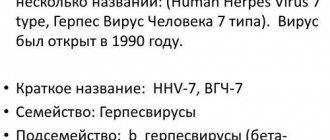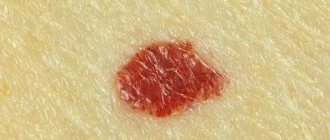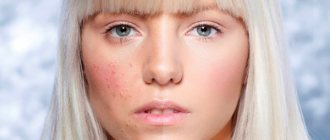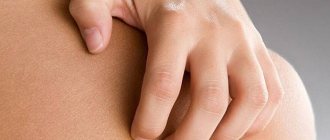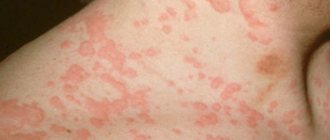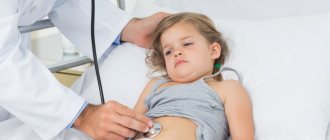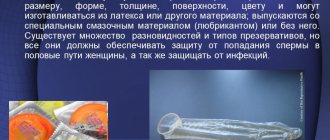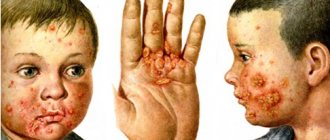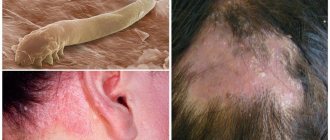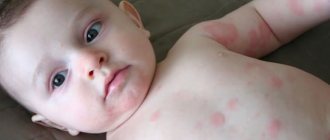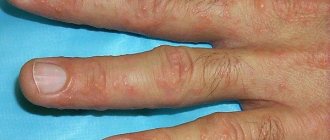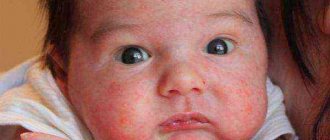Etiology
The fundamental provoking factor in the occurrence of such a dermatological disease is the increased susceptibility of the human body to external and internal irritants, which leads to the development of an allergic inflammatory process on the skin.
Pruritus most often affects people who are hypersensitive to protein foods - it is for this reason that dietary nutrition comes to the fore in the treatment of the disease.
Symptomatic manifestations of prurigo are often caused by the following ingredients:
- citrus fruits and strawberries;
- raspberries and strawberries;
- nuts and cocoa;
- egg white;
- chicken meat;
- chocolate and mushrooms;
- baked goods;
- Fish and seafood;
- honey and other bee products;
- Exotic fruits;
- smoked meats and spices;
- some types of coffee;
- alcohol.
It is worth noting that in order for a breastfed child to suffer from such a disease, it is enough for the baby’s mother to consume the above products.
The inflammatory-allergic process can also be triggered by the body's response to insect bites, in particular fleas, ticks and mosquitoes.
Despite the fact that the nutritional factor is the most common cause of the formation of such a pathology, the occurrence of other ailments can also serve as a source for its development. Pathological etiological factors are considered to be:
- neurasthenia;
- oncological neoplasms of any location;
- parasitic or helminthic infestations;
- intestinal dysbiosis;
- cholecystitis in acute and chronic form;
- biliary dyskinesia and other disorders of the gastrointestinal tract;
- chronic stressful situations and the course of other neuro-emotional pathologies;
- diabetes;
- cirrhosis of the liver;
- chronic course of hepatitis;
- lymphogranulomatosis.
It is extremely rare that prurigo develops due to prolonged exposure to sunlight on the skin - in such cases, the diagnosis of “solar prurigo” is made.
In addition, the disease can be caused by changes in the female body that occur during pregnancy.
Classification
Dermatologists usually distinguish the following most common forms of this disease:
- infantile pruritus - often diagnosed in children under 5 years of age, but the possibility of early appearance cannot be ruled out, for example, during the eruption of primary teeth or when introducing a new product into complementary foods;
- prurigo in adults - often develops in people who suffered from diseases such as diathesis and urticaria in childhood. The rash can be triggered by ingredients in dishes or autointoxication of the body that appears against the background of gastrointestinal ailments;
- senile prurigo - mainly affects people over 70 years of age suffering from endocrinological disorders, metabolic disorders and atherosclerosis. It is noteworthy that the disease often develops in females.
Separately, it is worth highlighting such a form as Hyde’s nodular prurigo - this type of disease is considered the rarest. It affects people with unstable mental health or a compromised immune system. The provoking factor is often chronic stress or severe nervous shock. The risk group consists of patients with endocrinological pathologies, as well as those with a history of damage to the liver or biliary system.
There are also two forms of prurigo in adults and children:
- acute;
- chronic.
Manifestation in adults
Beignet prurigo manifests itself as rashes that are nodular in nature. Rashes usually appear in the area:
- backs;
- belly;
- in places of flexion and extension of all limbs.
It is important to note that this form of the disease does not appear in the facial area. The size of the ulcers can reach 5–8 mm. They become covered with red or brown blood crusts. With the appearance of crusts on the body, patients begin to complain of severe itching.
The disease can be divided into two groups: chronic and acute. The chronic form gives symptoms such as constant severe itching and numerous defects on the skin of a cosmetic nature. This disease can lead to disturbances in the nervous system, sudden mood swings, and possible depression. When adult pruritus appears, treatment should begin as soon as possible.
Otherwise, complications may arise, such as:
- folliculitis;
- furunculosis;
- pyoderma;
- ostiofolliculitis.
A pathology such as prurigo in adults requires complex therapy.
Most often used:
- medicines that relieve itching and remove the underlying effects of an allergic reaction (Cetrin, Fenkarol, Suprastin, Tavegin, Kestin);
- pharmacological products that help relieve nervous tension, these can be either injections (Novocaine 2%, administered intramuscularly once every 2 days, 5 ml) or tablets (Novopasit, Valerian, Persen);
- If the patient begins to develop erosions, doctors prescribe intensive therapy.
In medical practice, advanced cases of this pathology are often encountered, and then doctors have to resort to extreme measures. And they prescribe hormonal drugs that help quickly combat the problem. In most cases, the drug used is Prednisolone. The course of treatment can last for 5–7 days, depending on the complexity of the disease. The dosage of the drug per day should not exceed 25 mg.
In case of complications that can result from pruritus in adults, treatment should be done with antibiotics or sulfonamide drugs. During the period of antibiotic use, the body must be strengthened with the help of various vitamin complexes and probiotics.
If the itching becomes unbearable during the period of illness, then the affected areas of the skin are treated using 1 - 2% menthol, 2% phenol or 2 - 4% citrate solution. Each of these drugs has strong antipruritic properties.
Symptoms
Symptoms of prurigo
Each of the varieties of this pathological process has its own clinical picture. For example, in patients with strophulus or infantile prurigo, the presence of the following signs is noted:
- the appearance of multiple rashes that look like small nodules, the diameter of which does not exceed 5 millimeters;
- the formation of vesicles with a small concentration of inflammatory exudate on the elements of the rash;
- localization of the rash on the upper and lower extremities, face and torso, but the largest number of nodes is concentrated on the extensor surfaces of the arms and legs;
- the appearance of erosions covered with crusts on the affected area of the skin - this occurs after spontaneous opening of the papules;
- the formation of papulovesicles up to 7 millimeters in size on the palms and soles - this symptom is expressed quite rarely;
- swelling and change in skin tone in the affected area;
- severe skin itching, causing scratching;
- sleep disturbance;
- increase in temperature indicators;
- increased irritability, moodiness and tearfulness;
- an increase in the size of regional lymph nodes;
- lack of sweat;
- white dermographism;
- dry skin.
Beignet's prurigo (the second name for prurigo in adults) occurs with the following symptoms:
- the appearance of itchy nodules in the area of the anterior wall of the abdominal cavity, on the buttocks and extensor surfaces of the upper or lower extremities;
- the rashes have a conical or spherical shape, a brown-red hue and a diameter of 5 millimeters. In addition, bright red papules may occur;
- severe itching of the damaged skin area;
- the formation of a hemorrhagic crust - this occurs after scratching the rash;
- frequent mood changes;
- complete lack of sleep.
Hyde's nodular prurigo or senile pruritus in adults often has a chronic course, and the symptoms of the disease are presented:
- the occurrence of rashes only on the extremities;
- a rash that looks like hemispherical papules of brown-red color, the size of which varies from the volume of a small pea to the size of a hazelnut;
- excessively severe skin itching;
- the formation of bloody crusts and scars.
Symptoms of prurigo in children
General information about pathology
The disease has several types: nodular, childhood, adult. Like all diseases, prurigo has quite pronounced symptoms. The most important task is when the first signs appear, such as unbearable itching, purulent rashes, and the appearance of bloody crusts in places where purulent blisters have been scratched.
It is very important to know whether this pathology is infectious or not. And how it is transmitted. Pathology spoils the appearance. Therefore, everyone tries to turn away from a person who suffers from this disease. But, as it turned out, it is completely safe for others. And it is not transmitted by airborne droplets or during close contact.
Diagnostics
Pruritus in children and adults is diagnosed by a dermatologist based on clinical data and the results of laboratory and instrumental examinations.
Primary diagnosis includes the following manipulations:
- familiarization with the medical history - this will help to identify pathologies against which such a dermatological disease may develop;
- collection and analysis of life history - to search for provoking factors that do not have a pathological basis;
- thorough examination and palpation of the affected area of skin;
- a detailed survey of the patient or his parents (if pruritus occurs in a child) - this is necessary to determine the first time the symptoms of pruritus appeared and the degree of intensity of their severity, which will also indicate the course of the disease.
For pruritus in adults and children, the following laboratory tests are necessary:
- general and biochemical blood test;
- microscopic examination of feces;
- bacterial seeding of the serous contents of the vesicles;
- hormonal tests;
- liver tests;
- bacterial culture of scrapings;
- analysis of feces for dysbacteriosis.
Instrumental procedures are limited to ultrasound.
In addition, consultation with a gastroenterologist and endocrinologist may be required.
Prurigo must be differentiated from:
- atopic dermatitis;
- scabies;
- toxicoderma;
- Lichen planus.
Traditional pharmaceuticals
A disease such as pruritus can be cured with the help of various pharmaceutical herbs, home remedies and methods.
The following remedies are effective for treating pruritus in adults:
- Starch baths (dissolve 50 g of starch in a bath). Take a bath for minutes.
- Baths with a decoction of birch buds (boil the buds, strain the decoction, add a bath).
The duration of the procedure is 30 minutes.
- Pumpkin-potato compress (put grated vegetables in cheesecloth, apply to affected areas). Leave for an hour or two.
- A decoction of lemon balm leaves, hop fruits and valerian roots, taken in equal parts. Boil, cool, take as a remedy to soothe itching.
- Grind the collection (5 parts linden blossom, 4 parts woodruff, part walnut leaves). Pour 2 teaspoons of the mixture into a glass of boiling water. Boil for 10 minutes, cool and drink the broth throughout the day 3 times.
Important.
It is necessary to use folk remedies after consultation with a doctor, as they may have contraindications.
Taking baths with dissolved medicinal herbs is effective.
Treatment
The treatment regimen is dictated by the nature of the disease. Treatment for prurigo in children includes:
- changing the diet of the child or mother (when breastfeeding the baby);
- oral administration of antihistamines and antibacterial agents;
- vitamin therapy;
- use of sedatives and food enzymes;
- local use of ointments and creams containing glucocorticoids;
- taking baths with a decoction based on chamomile or string, oak bark or bran.
A bath with chamomile infusion is an effective remedy for pruritus for children and adults.
Prurigo prurigo in adults can be eliminated with:
- local antihistamines;
- taking medications to relieve nervous tension;
- desensitizing therapy with corticosteroids;
- antibiotics and sulfonamides;
- use of ointments with anti-zone effect;
- physiotherapeutic procedures, in particular phonophoresis and electrosleep, ultraviolet irradiation and DDT, electrophoresis and inductothermy;
- following a diet for pruritus, aimed at avoiding allergy-provoking foods.
Therapy for Hyde nodular prurigo involves:
- use of corticosteroid ointments;
- taking topical steroids;
- use of antihistamines and restorative drugs;
- rubbing with menthol;
- injection of corticosteroids into the lesions.
Diet for pruritus
Since the disease is directly related to the state of the digestive organs, if you have purigo (pruritus), follow the following diet:
- Eat more low-fat dairy products.
- Eat more fruits and vegetables.
- Drink up to 1.5-2 liters of clean water per day.
- Limit your consumption of coffee and alcohol.
- Avoid spicy, salty, smoked foods.
- Eat less foods with carbohydrates (bread, baked goods).
There are also nutritional rules for kids:
- Give babies 10 drops of expressed milk 15 minutes before feeding.
- Do not include kefir and cottage cheese in your diet until 8-9 months.
- For older children, offer more dairy products, fruits and vegetables.
Important! If you refuse to diet, drug treatment is ineffective.
